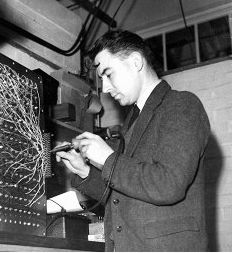| Andrew Booth and the Forgotten Computers |
| Written by Historian | |||||||
Page 3 of 3
To CanadaBTM had offered to set up a chair in Computer Engineering at Birkbeck for Booth in order to reward him but the then Chancellor and others caused the proposal to come to nothing. In disgust Booth decided to "depart from the hive of socialist mediocrity". Within a few days he had offers of chairs from the US, Canada and New Zealand. He chose Canada and became Professor at the Western Reserve University. Booth claims to have made the right choice and certainly did a lot for engineering education in Canada - but you can't help think that this was something of a loss to the UK computer industry. He did continue designing computers. The M3 was built at Saskatchewan University with the help of a graduate student and he worked from 1965 for ten years providing computing resources for the university. From 1972–1978 he served as President of Lakehead University in Ontario. He remained in Canada until his death in 2009 at the age of 91. LegacyHe seems never to have forgotten his own strange route through the education system and saw it as something that should be reproduced. In 1972 he started a "bright kids" program in Ontario which allowed almost anyone to take university level courses and have them credited against a degree when they finally got round to it. His own children were among the first to benefit. Both of them started studying at 12 and graduated when they were 16 with first class honours. He felt very strongly that people should be allowed to progress at their own rate and regarded the comprehensive education revolution going on in the UK as being an attempt to bring everyone down to the lowest common level. His only overtly political achievement was to be the only University President to be listed as an Anarchist in Who's Who.
Booth's MultiplierAs well as designing small computers and the magnetic storage drum Booth is also responsible for "Booth's Multiplier Algorithm" which is a sneaky method for multiplying two binary numbers together and is still used in today's computing devices such as smartphones. In those early days how to perform arithmetic was a problem and they didn't have the IEEE standard for floating point calculation to consult. Multiplying two binary numbers together is fairly easy in that it can be done using nothing but shifts and adds. Each shift multiplies the multiplicand by two and the adds accumulate the final result. You add the multiplicand to the partial product if the multiplier bit is 1 and do nothing if it is a 0. However this simple procedure only works for positive numbers. Negative numbers are generally represented by two's complement notation. That is -X is represented in binary as the positive number 2^n-X. This automatically gives you the correct answer when you do additions and subtractions but when you multiple a pair of two's complement numbers one positive and the other negative the answer is wrong and a correction factor has to be added. The correction factor depends on the pattern of positive and negative values. Booth came up with a simplified and more regular algorithm for working out a signed multiplication. The algorithm is:
You can see that this is very simple and should be easy to implement in hardware - but can you see how or why it works?
More InformationAndrew D Booth - Britain’s Other “Fourth Man” Related ArticlesComputer Pioneer Kathleen Booth Dies At Age 100 HEC 1950s Business Computer Goes On Display Alan Turing and his contemporaries (Book Review) To be informed about new articles on I Programmer, sign up for our weekly newsletter, subscribe to the RSS feed and follow us on Twitter, Facebook or Linkedin.
Comments
or email your comment to: comments@i-programmer.info |
|||||||
| Last Updated ( Monday, 31 October 2022 ) |


